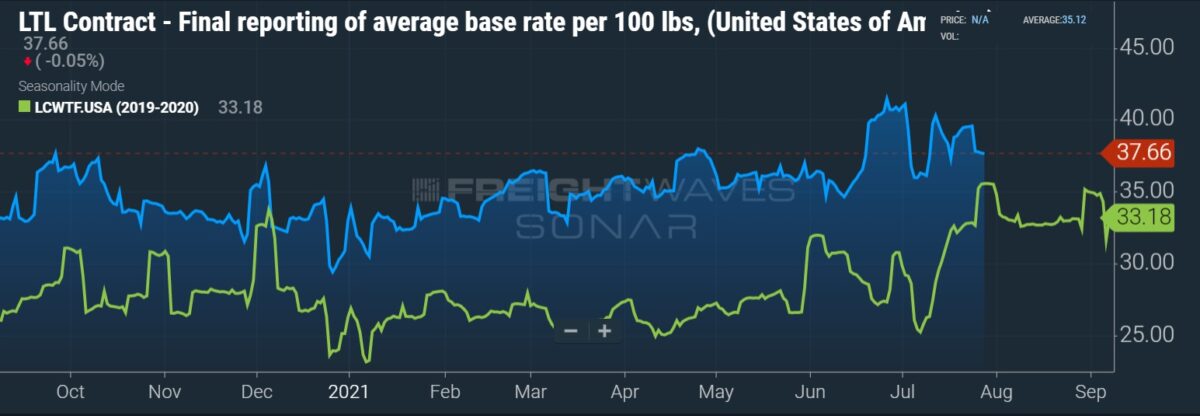Transportation and logistics provider ArcBest Corp. provided an update on August’s trends on Wednesday. The company’s asset-based segment, which includes less-than-truckload, saw tonnage decline 4% year-over-year during August, a turnaround from the 5% increase recorded during July.
The year-ago period (+3.7%) benefited from an unseasonal lift in the company’s moving and storage segment as well as more spot market shipments. ArcBest (NASDAQ: ARCB) is in the process of lowering its exposure to non-LTL shipments to better serve its core customers.
“The year-over-year and sequential decrease in total average daily tonnage and shipments was associated with the deliberate moderation of the number of U-Pack household goods shipments and other spot-quoted shipments in order to serve core LTL customers,” the filing read.
A decline in the heavier U-Pack shipments will weigh on future year-over-year tonnage comps moving forward, according to the filing.
The company didn’t specifically say it has embargoed service to any customers or locations but the industry as a whole has been working to keep nontraditional LTL freight out of its networks.
Revenue per hundredweight, or yield, was up 21% year-over-year in August following a 20% increase in the prior month. The comps, which include fuel surcharge revenue, compare to low-single-digit declines in the same months of 2020.

“On both a year-over-year and sequential basis, average daily August 2021 revenue, tonnage and shipments in the asset-based core LTL-rated business were some of the strongest in the last 10 years,” the report stated.
While the volume comp was lower in August, the company saw revenue continue to move higher. Asset-based revenue was up 16% year-over-year in August and 25% higher in July.
Other LTL carriers recently reported notable third-quarter gains compared to the same period in 2020, when the industry was still gaining traction following a lift of COVID lockdowns.
Old Dominion Freight Line (NASDAQ: ODFL) reported more sizable revenue increases in the first two months of the quarter with Saia Inc. (NASDAQ: SAIA) seeing tonnage continue to grow by double digits.

Industrial economy producing amid labor, parts and supply chain challenges
The mode that has become a freight catchall for lighter e-commerce-related parcel shipments and heavier spillover freight that should be moving full truckload is seeing an uptick from its traditional industrial customers.
The Manufacturing Purchasing Managers’ Index increased 40 basis points sequentially in August to 59.9%, according to the Institute for Supply Management. An index reading above 50% indicates growth in the U.S. manufacturing sector. The 12-month average for the index remained near 60%.
LTL shipments historically lag PMI data by three months. Industrial-related freight accounts for more than 80% of LTL shipments in some carrier networks.
Subindexes like new orders (66.7%), production (60%) and order backlog (68.2%) stepped higher. Manufacturing inventories (54.2%) increased but transportation delays throughout the supply chain and an increase in unfinished goods sitting at production facilities, which are struggling to find parts and employment (49%), were the reasons. Customers’ inventories (30.2%) increased but retained the “too low” designation.
Industrial production was up 0.9% sequentially in July, 6.6% higher year-over-year. A surge in automotive factory output (+11.2%) occurred as original equipment manufacturers and suppliers curtailed traditional July shutdowns. Production in the auto sector has been lumpy since shortly after the onset of the pandemic due to raw materials, parts and labor shortages.
The industrial production index is only 0.2% below pre-pandemic levels. Manufacturing capacity utilization of 76.1% remained 350 bps below its historical average.
ArcBest’s asset-light unit reported a 31% year-over-year revenue increase during the month of August, following a 47% jump in July.








Freight Zippy
Pretty decent cwt growing at a great rate.
Can Yellow do the same?
miced
I get paid over $87 per hour working from home with 2 kids at home. I never thought I’d be able to do it but my best friend
earns over 10k a month doing this and she convinced me to try. The potential with this is endless. Here’s what I’ve been doing… www.jobs70.com